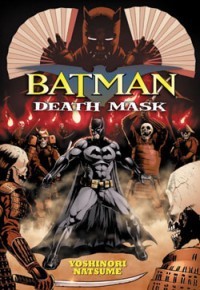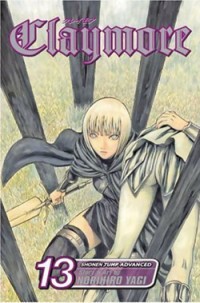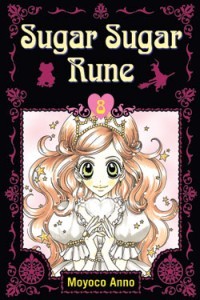RIGHT TURN ONLY!!
A Dark And Stormy Knight
by Carlo Santos,

What?! Naruto: Ultimate Ninja Storm came out last week! How did on earth did I almost miss this? I don't believe it!
'Scuse me ... I think I'm going to go spend some quality time with my PS3.
BATMAN: DEATH MASK

(by Yoshinori Natsume, DC Comics, $9.99)
FROM THE BACK COVER:
"There's a new serial killer in Gotham, who may have ties to the young Bruce Wayne's training in Japan. But does the murderer know Bruce Wayne is the Batman? Did his past experience somehow lead to a killer's rampage through the Gotham underworld today?"
EVIDENCE FOR:
Sometimes, the right artist, the right characters, the right story, and the right style all show up in the same place. Batman: Death Mask is one of those places: who better to work on DC's darkest A-list superhero than "the Togari guy," crafting a supernatural thriller that will keep readers guessing. Is Batman's latest villain a figment of his imagination ... his memory ... or a real-life threat? Is he fighting a shadow of his past ... or the future? Can I write the entire rest of this paragraph in question format? The ambiguity and mystery of Death Mask is the hook, and yet it still manages to reach a definitive ending, albeit one with a grim message that cuts to the core of Bruce Wayne's identity and pseudo-identity. An extended flashback about Bruce's time studying martial arts in Japan also adds depth to the overall Batman mythos. Of course, this tragic tale would be nothing without Natsume's intense, moody artwork, full of shadow and texture that works especially well during the dream sequences. Whether raging with action or deep in contemplation, the Dark Knight's adventures are dramatic as ever.
EVIDENCE AGAINST:
The story, mood and style all fit nicely, but what about the placement of international boundaries? In trying to strike a balance between the manga approach and traditional superhero style, the end result is some seriously awkward layouts. At times, it looks exactly like the worst examples of East-West crossover comics—someone just drew big eyes and shiny spiky hair inside a bunch of 2-by-3 rectangular panels. This isn't helped by scenes that involve entire paragraphs inside the dialogue bubbles, or thickly-filled narration boxes; once you start obstructing the flow by throwing whole walls of text at the reader like typical Amecomi, then it pretty much ceases to be manga (unless it's Death Note, but anyway). The background about Bruce Wayne's training stint in Japan, as well as the whole plot hinging on a Japanese legend and a Japanese conglomerate and various Japanese characters, also smacks of contrived international-crossover cheese—why not just tell a good story without blatantly calling out the nationality of the author?
FINAL VERDICT:
One day, manga-ka will be able to do superhero-crossover stories without feeling self-conscious about it, but this one is still an enjoyable action piece with a hint of horror—so it gets a B-.
CLAYMORE

Vol. 13
(by Norihiro Yagi, Viz Media, $7.99)
FROM THE BACK COVER:
"In a world where monsters called Yoma prey on humans and live among them in disguise, humanity's only hope is a new breed of warrior known as Claymores. Half human, half monster, these silver-eyed slayers possess supernatural strength but are condemned to fight their savage impulses—or lose their humanity completely.
Audrey and Rachel continue their battle against Riful of the West, and Clare learns some surprising truths about Priscilla, Isley and the struggle for power amongst the Three Great Awakened Ones. Meanwhile, the Organization decides to send Miata and Clarice out on an important mission, but will Clarice be able to keep her unstable young charge in line?"
EVIDENCE FOR:
Sports teams know it, and now the warriors of Claymore know it too: experience almost always beats youth. This volume begins with the series' bread and butter—a blistering two-on-one swordfight—but it's the negotiation tactics of Clare and "the warriors from seven years ago" that save the brash new Claymores from getting themselves killed. What happens next is a nice little interlude from the usual nonstop action, also explaining just what happened during the timeskip. For those who want more hack-and-slash, though, the other plotline involving Miata is as action-packed as it gets, with some particularly gruesome kills along the way. Don't you just love child characters that turn out to be terrifying ruthless killers? A couple of side stories also explore the emotional ups and downs of the Claymores' existence: one involving Teresa (haven't seen her in a while!), and a heartbreaker featuring Miria. All in all, a neat little grab bag of tales from the Claymore universe, all told with perfect and delicate art, of course—rich scenery, striking angles, and eye-popping swordfights that make you stand up and cheer.
EVIDENCE AGAINST:
Ever get the feeling that Norihiro Yagi planned as far as the Battle of the North and then wasn't sure where to go next? The timeskip was dramatic enough to distract from that, but now that we've got our bearings, it's starting to look like a band of warriors lost without a plotline. Clare and company basically show up for an infodump (come on, nobody reads this series for negotiation skills), then it veers off into the Clarice/Miata storyline, which doesn't really hit any dramatic points at this stage, and then ... one-shots. How is anyone supposed to stay hooked on the series when nobody knows which storyline to focus on? There's even something disappointing about the art, despite its unwavering consistency: Yagi's just drawing the same bland-faced girls and the same forests and the same rocky outcroppings over and over again. Anyone else having trouble identifying each of the individual Claymores by sight? Having a unique style only gets you so far, and if the story's not there to make things pop, this series runs the danger of falling flat.
FINAL VERDICT:
Disconnected plotting and side-story fillers. I think that says it all, as this stage of the saga disappoints with a C.
KAMICHAMA KARIN CHU

Vol. 2
(by Koge-Donbo, Del Rey, $10.95)
FROM THE BACK COVER:
"Now that Karin has found all of the three noble gods, it's time to join forces to save the future! But when Karin overhears Kazune saying he doesn't want her around, she's afraid their plans are already doomed. Will Karin's dream of saving the day end before it even begins?"
EVIDENCE FOR:
Who cares about saving the future? Let's see Karin's boy-harem bickering with each other! That's this volume's selling point, as we see ornery Kazune and high-strung Jin going at it in classic love-triangle fashion. The best chapter is the body-switch one, where Jin discovers the privileges of being Kazune and starts putting the moves on Karin in this scandalous yet adorable way. Actually, Jin tends to put the moves on Karin regardless, and his cocky, forward attitude brings a lot of energy to this relationship. Just as amusing is the side story that flashes back to the original series, as mistaken identities and wacky outdoor adventures turn out to be a wonderful distraction. As always, the artwork's strong point is its supercute sense of design coupled with sharp, bold lines, and Koge-Donbo isn't past throwing in a little bit of bishonen fanservice either.
EVIDENCE AGAINST:
Okay, so it's not as horrifically confusing as the first volume that tried to explain the origin story behind some mind-boggling magical quest, but now that it's gotten into episodic adventure mode, it's still pretty bad. Each chapter basically involves frivolous love-love complications for about 25 pages, and then in the final scene, blasting an evil "chaos seed" with the power of sparkles. Yes, this is as dumb as it sounds. Even a "To Be Continued In Volume 3!" cliffhanger doesn't help that much, because there is no sweeping arc toward that moment, and packing a side story into the last 40-odd pages basically cripples the amount of story content for the main series. Meanwhile, sloppy scene transitions and unconvincing character behavior make it difficult to get into the story; Jin and Kazune's antics may be well suited to a gag manga (we are talking about the creator of Digi Charat after all) but they definitely don't sell on the magic-fantasy-romance aspect. And as usual, the art trips over itself with overtoning, cluttered paneling, and no room for the eyes to rest. You want to know how to do magical girl series right? See further down.
FINAL VERDICT:
It's not getting any better. With an empty-headed storyline and an artistic approach that leaves a mess wherever it goes, this is no more than a D.
SOLANIN

(by Inio Asano, Viz Media, $17.99)
FROM THE BACK COVER:
"Meiko Inoue is a recent college grad working as an office lady in a job she hates. Her boyfriend Naruo is permanently crashing at her apartment because his job as a freelance illustrator doesn't pay enough for rent. And her parents in the country keep sending her boxes of veggies that just rot in her fridge. Straddling the line between her years as a student and the rest of her life, Meiko struggles with the feeling that she's just not cut out to be a part of the real world."
EVIDENCE FOR:
Trying to review Solanin from an objective technical standpoint is practically unfair. This is a work so heartfelt, so deeply affecting, that it's impossible to read it without feeling the emotional pull. But perhaps that's one of its technical merits after all: the way it projects the characters' feelings so vividly, telling a story that curves from restlessness to despair to hope and redemption. The pace is gentle throughout, yet the emotions become ever more powerful as the story progresses—especially after that incident at the halfway point where Meiko has to seriously rethink her life. The last few chapters are the crowning point of this single-volume series, using rock music as a coming-of-age metaphor in ways that surpass even Beck. But to get a feel for the story in general, think Honey and Clover minus the romantic entanglements, plus some urban-modern existentialism, and better draftsmanship. Ah, yes, the art: even with strictly rectangular panels and minimal effects, the expressiveness is unmistakable—especially the characters' faces and gestures at the high and low points of their lives. Light and shade, too, add so much to the atmosphere, and to give an idea of just how much attention to detail there is: Meiko's hair actually grows as time passes. On the big and small scale, everything is just ... beautiful.
EVIDENCE AGAINST:
Okay, so, anyone who isn't between the ages of about 20 and 30 ... this isn't for you. Once again, critics drool Pavlovially over some post-college hipster-slacker navelgazing session expressed through sequential art. Not a knock against Asano or anything, but Solanin was clearly created by and geared towards a specific generation, and for those who haven't experienced the uncertainty of 21st-century part-timing and job-hunting, or missed out on the Millenial chasm of being too old to be parentally dependent but too poor to break the apron strings ... well, the feelings expressed in this story might ring a little hollow. But what do I know about people outside my demographic. Either way, this series lays it on pretty thick with the life-contemplating monologues, echoing the usual platitudes of every "alternative" comic and wasting space when it's not sure where to go next. Fortunately the story figures itself out eventually, but before that, it kind of drifts aimlessly ... just like the characters.
FINAL VERDICT:
Oh, come on, I am part of that generation. Of course I'm going to like it. So take this A- and see for yourself if Solanin is worthy of the praise it gets.
SUGAR SUGAR RUNE

Vol. 8
(by Moyoco Anno, Del Rey, $10.95)
FROM THE BACK COVER:
"Chocolat and Vanilla are in the fight of their lives. Chocolat must confront her own father—Glacé, the King of the Underworld—to save Pierre, Woo, and the familiars from the brink of death! All the witches must unite to fight Glacé and his Ogres; even former enemies such as Alchimie join in. Will this be enough to defeat Glacé and save the Magical World? And don't forget about the contest! Who will finally be crowned queen: Chocolat or Vanilla?"
EVIDENCE FOR:
Mind ... blown. Can't ... think .... of words ... Sorry, I'm still recovering from one of the most satisfying, most creative, most epic endings to a fantasy series ever. There are many elements to this kind of story, and Moyoco Anno gets every single one of them right: the white-knuckled final stage of Chocolat and Vanilla's journey to the Underworld, the shocking release of the final villain, the dramatic all-guns-blazing battle for the Magical World, the return of characters from several volumes ago, the tragic death of a some who's been around since Volume 1, and of course ... the triumphant, redemptive finale where love, friendship and self-sacrifice beat everything else. Yeah, when you get down to it, it's basically Gurren-Lagann with sparkles and magic—where a runty schoolkid can, with sheer willpower, save the freakin' universe. Is it any surprise, then, that Anno pulls out all the artistic stops for this finale? The journey through the Underworld is one brilliantly conceived scene after another, followed by the blockbuster special effects-laden final battle, and by the time Chocolat unleashes her final round of magic ... well, prepare to have your eyes and your mind blown. Any fool can draw a doe-eyed heroine with sparkly powers. It takes a genius artist to make you believe in that heroine with all your heart.
EVIDENCE AGAINST:
The only possible shortcoming of this ending is that—through no fault of its own—the dramatic high and low points were pretty much set by Volume 7, and this one basically ties up loose ends. It may be lacking in surprising twists (well, maybe one or two) or coming-of-age trials, but it seems unfair to knock a fantasy ending for doing what fantasy endings do. But there is one point of contention: Anno really dogged it on the creature designs for the Ogre tribe, throwing out some random spiky creatures that lack the stylishness and confident linework of all the other characters. But oh well, they were just cannon fodder anyway.
FINAL VERDICT:
The greatest fantasy comic of the last 5 years has just ended its publication run in America and nobody cares. Oh well, I'll just give it an A- and cry sad tears over why there aren't more fans of Sugar Sugar Rune.

KANNAGI

Vol. 1
(by Eri Takenashi, Ichijinsha, ¥552)
FROM THE BACK COVER:
"One day, Nagi, a strange girl in many ways, appeared in front of Jin, an ordinary high school student. Is she really the goddess she claims to be? Indeed she is! And so begins their lives under the same roof."
EVIDENCE FOR:
Yeah, yeah, you think Kannagi (hilariously subtitled "Crazy Shrine Maidens") is just another wish-fulfilment device where the common teenage male finds an uncommonly hot girl falling into his lap. Yet this breezy, likable comedy quietly subverts what we know about the genre: instead of trying to get into Jin's pants, Nagi is typically found exercising her godly powers and being a capricious pain in the butt, and Jin, instead of trying to contain his manly urges, is typically found trying to contain Nagi's madness. A colorful supporting cast makes things even more entertaining, as Jin's schoolmates include: an otaku with a self-loathing art-snob complex, a strong silent type with a soft side, and some art club girls who may or may not be closet fujoshi. But it's still Nagi's nutty behavior that steals the show, from misadventures with superglue, to wand-waving exorcism action, to an impossibly perky, over-the-top entrance at Jin's school. Clean, precise artwork puts visual clutter aside and lets comedy come to the fore, and the distinctive character designs—from Nagi's flashy looks to the individual students—result in a memorable ensemble that should bring plenty of laughs.
EVIDENCE AGAINST:
But is it not doing enough to subvert a well-worn genre? Structurally, Kannagi follows all the old conventions like having the girl enter the guy's life by a complete stroke of luck (although it does it in record time), and then going through the usual routine of doing random things to annoy him, having various culture shocks about modern-day life, visiting his school, meeting a rival, and all that junk that other series have done before. Besides, the rest of the girls who are meant to be Nagi's competition are a bore: childhood friend Tsugumi is just kind of there, and the "other goddess" Zagen is introduced too late in this volume to really get a grasp of her character aside from some superficial traits. Lastly, something must be done about artists these days who think background art is optional. Yes, it's nice that you can draw clean and cute, but where are the characters standing? Goodness gracious.
FINAL VERDICT:
There's a certain comfortable familiarity here—while at the same time being sprightly and offbeat enough to avoid being called a ripoff. With all the energy she brings, Nagi is the kind of girl that other romantic-comedy heroines should aspire to be.

In my time, I've read manga about all sorts of unlikely subjects. Alchemy. Competitive breadmaking. Classical music in academia. Fledgling schoolteachers and the third-grade girls who love them. But this passionate review from S. Skiff reminds us of one that a lot of people may have missed: firefighting!
FIREFIGHTER! DAIGO OF COMPANY M

(by Masahito Soda, Viz Media, $9.95 ea.)
I would like to draw people's attention to what has been (until today) an overlooked gem.
Firefighter! Daigo of Fire Company M is without qualification the greatest manga I have ever read since I became an anime/manga fan some 20 years ago. There is no violence, but there is plenty of action. There are no villains, but there are lots of heroes and intense rivalries. The characters don't have superpowers, but superheroes aren't as brave as Daigo Asahina.
Daigo Asahina is fresh from the academy. He's boiling over with excitement and a thirst for action when he's assigned to a sleepy little firehouse called "Company M." At first, Daigo is indignant and thinks his comrades lack the spirit necessary to be firefighters. When Company M is suddenly called into action, their true nature shines through, and Daigo realizes he still has much to learn about himself and what it means to be a hero.
He'd better learn fast, because the community surrounding Company M is growing at an exponential rate, including a new airport not unlike the real one found in Kansai. The sudden growth is causing problems for all the firehouses as their resources are spread thin and fires are on the rise.
Daigo finds a father-figure in his Captain Gomi, who may or may not have been the same man who saved Daigo and his puppy, Giles, from certain death. He has a crush on his former High School teacher, Ms. Ochai, who inspired him to become a firefighter. His relationships with other people are dynamic and make every volume more interesting than the last. However, most people will read Firefighter! Daigo of Fire Company M for the action.
With every rescue, author Masahito Soda slowly raises the tension to the breaking point. You'll stand up and cheer every time Daigo breaks the rules, cheats death, and saves the day. Daigo has a talent for sensing danger and getting to the victim. His instinct gets sharper just when all hope seems lost. This book pulsates with excitement and Daigo doesn't disappoint. His unorthodox methods and penchant for breaking the rules gets him into trouble with the top brass often. They recognize his talent, but they're also afraid one day his luck will run out.
I'm not ashamed to say that I grew to love the characters so much I cried more than a little when Firefighter! Daigo of Fire Company M came to an end. I still miss him. I doubt I will feel this passionately about any other manga.
Thank you, Daigo.
Is there a hidden gem of manga you'd like to reveal to the world? Is there a piece of garbage that deserves to be bashed in public? Or is there a title that didn't get a fair grade here, and you want to set the record straight?
Now's YOUR chance to be the reviewer! Write a review of about 300-400 words (a little more or less is fine) and include:
- Your name
- Title of manga (and volume no., if applicable)
- Author/Artist
- Publisher
- Briefly describe the story, then explain why this manga is great, terrible, or in between. Be objective, but also be entertaining.
Then send it in to rtoreaders (at) gmail (dot) com. One review will be selected out of all the submissions and will be published in the next column. All types of manga and manga-inspired comickry are accepted, from past and present, from Japan and beyond—what matters is that it's the Reader's Choice! NOTE: Submissions may be edited for formatting and grammar.
discuss this in the forum (46 posts) |